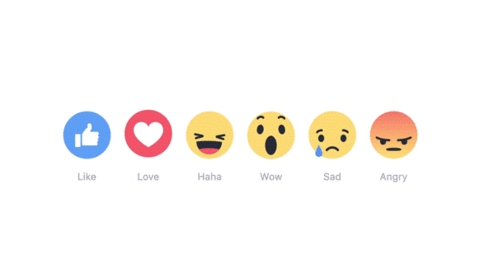If you’ve been anywhere near an internet-connected device in the last 48 hours, you’ll know what I’m talking about; Facebook’s released it’s new ‘Reactions’ to all users. We reported back in September 2015 about the first rumblings of then, when Mark Zuckerberg announced that while his team was not building the much-rumored ‘dislike’ button, they were in fact “working on it” when it came to ways for people to express a broader range of emotions on Facebook.
When you logged on to Facebook yesterday and saw an adorable line-up little faces staring back at you, you probably first reacted as a Facebook user, and then quickly put your brand hat on and said “what does this mean for my business?”

Source: WIRED
If you found yourself running through a range of emotions in response to this update, that seems like the most appropriate confirmation of what Facebook’s research team uncovered about our general reactions to things as human beings.
Let’s take a closer look at the reactions you may have had to this news, organized into six neat categories that may seem just a little familiar:
LIKE
Brands should like this new offering from Facebook because it’ll make the social network’s News Feed a more engaging and (hopefully) positive place to be. And the more people engage and spend time on Facebook, the more likely it is that they’ll run into a post or an ad that relates to your brand.
Before, the only options were to like, or not to like. So if simply liking a post didn’t quite do it, people would often just not engage in any way. And we all know that the more engagement your content receives on Facebook, the better it fares with the algorithm that determines how many people will eventually see it. So the more ways there are to engage with content, the more likely it is that your content will be seen as engaging (or course, this is true for all of your competitors too, so take this with a grain of salt!)
LOVE
As eluded to above, one of the effects of these expanded options will be to give Facebook users a broader range of emotions they can express, leading to more engagement. As Cassie Bendall from Strategiq marketing points out:
“Usually, when pushing out content on Facebook, there will be a percentage of your community who will engage actively, another percentage who may feel the desire to leave a negative comment here and there, and usually, more often than not, the majority who will see your content and feel unmoved to ‘like’ or ‘comment’ on it, these users would probably simply ignore it. However with a much wider choice of reactions becoming available, this large percentage of silent users may just find a voice and start becoming more vocal on your page.” (Strategiq)
By lowering the barriers to engagement and making it a little more fun, Facebook’s creating more opportunities for the people whose reaction lies somewhere between ‘like’ and ‘comment.’ Since engaging more intimately with members of your audience is pretty much the whole reason your brand is on Facebook in the first place, we give this one a ‘love.’
HAHA
Whenever changes like this occur, there are always little unintended ramifications that are mildly amusing, if unavoidable. Because Facebook now has to generalize the way people engaged with content (instead of saying ‘liked’ or ‘commented’) we have ended up with the very vague ‘reacted to.’
As I looked through my news feed today, I was informed that one of my friends had ‘reacted to’ a photo that his wife posted. Where I might previously have been told that he ‘liked’ that photo, now I’m left wondering if he liked it, loved it, was wowed by it, found it sad, or was angered by it. Does this matter in the grand scheme? No. Will it make me chuckle every time I see it? Yes.
WOW
If you’re not feeling wowed by the new Facebook reactions feature yet, consider this: the whole reason this finally came about is because of mobile device usage. While that might not blow your mind, it does warrant some consideration. Twenty years ago, very few people had mobile devices. Today, one of the most powerful and highly valued companies in the world is making product investment decisions based on our aversion to taking 15 seconds to type out a comment on the screen of a magical pocket computer. Consider this summary in a piece by Liz Stinson on WIRED:
“…in December of 2015, 1.44 billion people accessed Facebook on mobile. Of people who access it on both a monthly and daily basis, 90 percent of them do so via a mobile device. Commenting might afford nuanced responses, but composing those responses on a keypad takes too much time. People needed a way to leave feedback that was quick, easy, and gesture-based, says Zhuo. Emoji, it seemed, were the best option.” (WIRED)
SAD
Wondering who would react to this update with sadness? Think of the person in charge of social media reporting. Previously, their job included reporting on total engagement, likes, shares, and comments. Now, they will be reporting on total engagement, total reactions, likes, loves, hahas, sads, angries, shares, and comments.
Sad yet?
ANGRY
Okay, angry is probably overstating it for this one, but there isn’t a “mildly concerned” emoji (yet). In the same way that it is positive that these emoji will give the silent members of your audience a voice, it might also create a situation where people are expressing a vague sense of anger about something without actually stating a specific issue that someone in customer service can address.
If a customer is upset about something, it doesn’t help the brand or the customer for that person to react simply with an angry emoji and move on. The concern here is that a post might get a number of negative reactions, but no real opportunities for you to respond in a way that will resolve the issue. If you notice this happening, take a look at what else is going on in your business and see if you can at least use the sentiment to help identify a trend that you can address for the future.
All in all, we’re pretty excited about this update here at Pagemodo. Anything that makes Facebook a better place to hang out it okay in our book. And we’re happy to see that Facebook’s researchers really look their time looking at the way people behave, and came up with a thoughtful and customer-centric update addresses not just an advertising opportunity, but a real user need.
[Source:- Socialmediatoday]










